
Freesia is a genus of herbaceous perennial flowering plants in the family Iridaceae, first described as a genus in 1866 by Christian Friedrich Ecklon (1886) and named after the German botanist and medical practitioner, Friedrich Freese (1795-1876). It is native to the eastern side of southern Africa, from Kenya south to South Africa, most species being found in Cape Provinces. Species of the former genus Anomatheca are now included in Freesia. The plants commonly known as "freesias", with fragrant funnel-shaped flowers, are cultivated hybrids of a number of Freesia species. Some other species are also grown as ornamental plants.

Sphaeralcea is a genus of flowering plants in the mallow family (Malvaceae). There are about 40-60 species, including annuals, perennials, and shrubs. Most originate in the drier regions of North America, with some known from South America. They are commonly known as globemallows, globe mallows, or falsemallows. The name of the genus is derived from the Greek words σφαῖρα (sphaira), meaning "sphere," and αλκεα (alkea), meaning "mallow."

Cutis laxa or pachydermatocele is a group of rare connective tissue disorders in which the skin becomes inelastic and hangs loosely in folds.

Freesia laxa, commonly known as flowering grass, is a small species of cormous flowering plant in the family Iridaceae, from eastern and southern Africa, from Kenya to northeastern South Africa. It is grown in gardens as an ornamental plant.
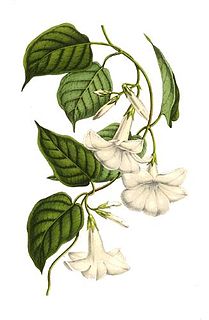
Mandevilla laxa, commonly known as Chilean jasmine, is an ornamental plant in the genus Mandevilla of family Apocynaceae.
Sphaeralcea incana, with the common names gray globemallow and soft globemallow, is a desert plant in the mallow family (Malvaceae).

Triteleia laxa is a triplet lily known by several common names, including Ithuriel's spear, common triteleia and grassnut. It is native to California where it is a common wildflower, and it is occasionally found in southwestern Oregon. It bears a tall, naked stem topped with a spray of smaller stalks, each ending in a purple or blue flower. The flower is tubular, opening into a sharply six-pointed star. The plant grows from a corm which is edible and similar in taste and use as the potato. The most used common name for the species, Ithuriel's spear, is a reference to the angel Ithuriel from Milton's Paradise Lost.
Desert mallow is a common name for several plants and may refer to:

Sphaeralcea coccinea, the scarlet globemallow, is a perennial plant growing 10–30 cm tall from spreading rhizomes with a low habit. They have grayish stems with dense, star-shaped hairs and alternately arranged leaves. The leaf blades are 2–5 cm long, palmately shaped, and deeply cut, with 3–5 main wedge-shaped segments. The undersides of the leaves have gray hairs. The 2-cm-wide flowers are reddish-orange and saucer-shaped, with 5 notched, broad petals, in small terminal clusters. Plants flower from May to October.
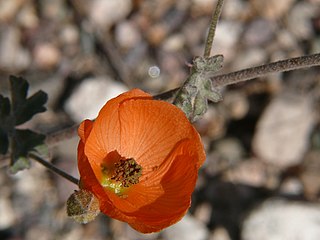
Sphaeralcea ambigua, commonly known as desert globemallow or apricot mallow, is a member of the genus Sphaeralcea in the mallow family (Malvaceae).
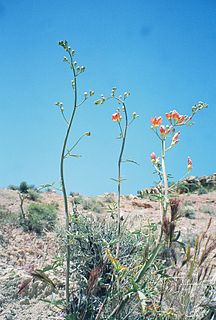
Sphaeralcea gierischii, Gierisch's globemallow or Gierisch mallow, is an endangered species of flowering plant in the mallow family, Malvaceae. It is native to the western United States, where it is known only from Utah and Arizona. It was described in 2002.
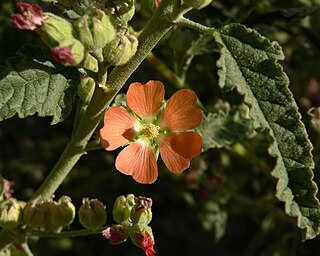
Sphaeralcea angustifolia is a species of flowering plant in the mallow family known by the common names copper globemallow and narrow-leaved globemallow. It is native to the southwestern United States as well as northern and central Mexico, where it grows in desert and plateau habitat. It produces many erect stems, approaching three meters in maximum height. It is woolly or felt-like in texture. The gray-green leaf blades are lance-shaped and measure up to about 5 cm long. They have wavy or slightly lobed edges. The leafy inflorescence bears several flowers each with five wedge-shaped orange petals just under 1 cm in length, and yellow anthers.

Sphaeralcea coulteri is a species of flowering plant in the mallow family known by the common name Coulter's globemallow. It is native to the Sonoran Desert, its distribution extending from northern Mexico north into California and Arizona. It is an annual herb, its slender, hairy stems sprawling or growing erect to a maximum height near 1.5 meters. The thin, gray-green leaf blades are wide and short, heart-shaped or triangular in shape, and measure up to about 5 centimeters long. They have a few wide lobes along the edges which may have teeth or smaller lobes. The leafy inflorescence bears clusters of flowers each with five wedge-shaped orange petals around a centimeter long, and yellow anthers.

Sphaeralcea emoryi is a species of flowering plant in the mallow family known by the common name Emory's globemallow. It is native to the Southwestern United States, California and Northwestern Mexico. It grows in desert habitat and sometimes disturbed areas such as roadsides.

Sphaeralcea grossulariifolia is a species of flowering plant in the mallow family known by the common name gooseberryleaf globemallow. It is native to the western United States, where it can be found in the Great Basin and surrounding regions. It grows in sagebrush, woodlands, playas, and the canyons of the upper Colorado River. It is common in disturbed areas, such as habitat recently cleared by wildfire.

Sphaeralcea munroana is a species of flowering plant in the mallow family known by the common names Munro's globemallow and Munro's desert-mallow. It is native to the western United States, where it can be found in the Great Basin and surrounding regions. It grows in sagebrush, desert flats, and mountain slopes. This perennial herb produces erect stems up to about 80 centimeters tall from a thick root system. It is woolly and gray-green in color. The alternately arranged leaves have triangular blades up to 6 centimeters long, usually edged with large lobes and a toothed margin. Flowers occur in clusters on a raceme-like inflorescence. The flower has five apricot to red-orange petals each just over a centimeter long.
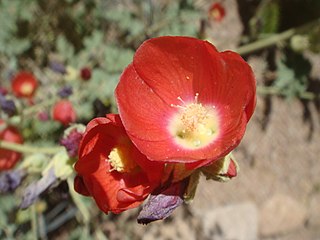
Sphaeralcea rusbyi is a species of flowering plant in the mallow family known by the common names Rusby's globemallow and Rusby's desert-mallow. It is native to the southwestern United States, where it can be found in various types of desert habitat. The species is generally divided into three subtaxa which grow in separate sections of the desert southwest. In general, the plant produces hairy or woolly stems which can reach three meters tall. The leaves are lobed or compound. The flowers each have five red-orange petals up to 2 centimeters long.
Dacryodes laxa is a tree in the family Burseraceae. The specific epithet laxa is from the Latin meaning "loose", referring to the inflorescence.
Persoonia laxa is a rare, probably extinct, shrub native to the Sydney region in eastern Australia.














